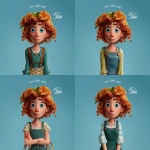Explore the Best AI Image Gallery
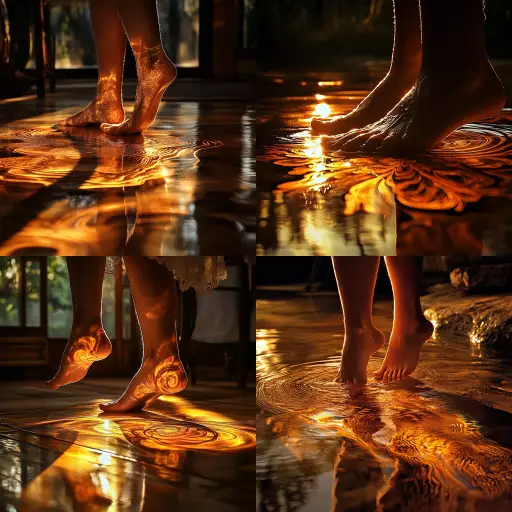
The Algorithms Brushstroke: How AI is Reshaping Graphic Design
The world of graphic design is undergoing a radical transformation, driven by the burgeoning field of artificial intelligence (AI). From generating stunning visuals to automating tedious tasks, AI is empowering designers to push creative boundaries and achieve new levels of efficiency. This blog post explores the multifaceted impact of AI on graphic design, examining its potential uses, ethical considerations, and future trends.
AI-Powered Design Tools: A Creative Playground
A plethora of AI-powered design tools are now available, offering a wide range of capabilities to designers. Some prominent examples include:
- Generative Design Software: These tools utilize algorithms to create unique designs based on user-defined parameters. For instance, Adobes Firefly and Midjourney can generate logos, illustrations, and even website layouts from simple text prompts.
- Image Editing and Enhancement AI: Tools like Luminar AI and Topaz Labs utilize machine learning to enhance images, remove blemishes, adjust lighting, and perform other complex edits with remarkable accuracy.
- Font Generation AI: AI can now design unique fonts based on specific styles or characteristics. This opens up exciting possibilities for creating personalized typography that reflects individual brands or projects.
These tools not only streamline the design process but also empower designers to explore novel creative avenues, generating ideas and concepts they might not have conceived otherwise.
The Human Touch: Collaboration and AI
While AI offers immense potential, its crucial to remember that its a tool to augment human creativity, not replace it. The most effective designs often arise from a harmonious collaboration between designers and AI.
- AI as a Design Assistant: Designers can leverage AI to automate repetitive tasks like resizing images, creating color palettes, or generating basic layouts, freeing up their time to focus on the more conceptual aspects of design.
- Overcoming Creative Blocks: AI can serve as a source of inspiration by generating diverse design options or suggesting unexpected combinations. This can help designers overcome creative blocks and explore new possibilities.
- Data-Driven Design Decisions: AI algorithms can analyze vast amounts of data to identify trends, user preferences, and design patterns. This insights can guide designers in making more informed and effective design choices.
The future of graphic design lies in a symbiotic relationship between human ingenuity and AI capabilities, where each complements the other to create truly exceptional designs.
Ethical Considerations: Navigating AIs Impact
As AI becomes increasingly integrated into design workflows, its essential to address the ethical implications associated with its use:
- Bias in AI Algorithms: AI models are trained on massive datasets, which can inadvertently perpetuate existing societal biases. Designers must be mindful of this and strive to mitigate bias in AI-generated designs.
- Copyright and Ownership: The question of copyright ownership for AI-generated designs is still under debate. Its crucial to establish clear guidelines and regulations to address intellectual property rights in the context of AI design tools.
- Transparency and Explainability: Designers should strive for transparency in their use of AI, clearly communicating how AI tools are employed in the design process. Additionally, efforts should be made to make AI decision-making processes more explainable to users.
By proactively addressing these ethical considerations, we can ensure that AI empowers designers and benefits society as a whole.
Future Trends: The Evolution of AI-Powered Design
The field of AI in graphic design is constantly evolving, with exciting trends emerging on the horizon:
- Personalized Design Experiences: AI will enable highly personalized design experiences, tailoring designs to individual user preferences and needs. This could revolutionize fields like e-commerce, marketing, and education.
- Immersive Design for AR/VR:** AI will play a crucial role in creating immersive design experiences for augmented reality (AR) and virtual reality (VR) applications.
- AI-Driven Prototyping: Designers will leverage AI to rapidly prototype and iterate on designs, accelerating the creative process and enabling faster decision-making.
As AI technology continues to advance, we can expect even more innovative applications in graphic design, blurring the lines between human creativity and artificial intelligence.
Conclusion
AI is undoubtedly transforming the landscape of graphic design, offering unprecedented opportunities for creativity, efficiency, and innovation. By embracing these advancements while addressing the ethical considerations, designers can harness the power of AI to create truly groundbreaking designs that shape the future of visual communication.

](https://images.ai-img.art/thumbnails/150/4f3d83c4b1d979b5be00f4ea80d67b71c0335bc1163e692d738e553ac37709e5.webp)
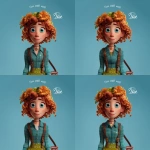

](https://images.ai-img.art/thumbnails/150/5487dcbcab0cd5702a67cc6819342ef56c05d0fc7730bfb7718ee291f10c3da3.webp)


![**ultra detailed 8k cinematic black and white beauty portrait of a young woman from chest up, vertical frame, face, hands and hair filling the composition, smooth neutral grey studio background with soft dark vignette on the edges, center of the frame is her eye, lips and finger in a "shh" gesture oval symmetrical face with soft but well defined features, ultra smooth flawless skin, no pores, no wrinkles, perfect beauty retouch, straight elegant nose with soft highlight along the bridge and gentle shadow under the tip full sensuous lips with a sharp cupid’s bow, slightly parted, a thin bright glossy highlight strip on the lower lip emphasizing volume, subtle light reflection on the lip gloss one eye visible through a gap between fingers, other eye mostly hidden by the upper hand, long thick eyelashes like fake lashes, small bright catchlight in the pupil, upper eyelid with smoky eye makeup, darker tone along lash line fading smoothly towards the brow, dark thick well shaped eyebrows, gently arched, not overdramatic dark wavy hair, big glossy waves falling down, one clear S-shaped wave on the right side of the frame, soft highlights along the strands to show texture, hair swept away from the cheeks so the face is not covered both hands in thin semi-transparent black gloves up to the forearm, upper hand placed horizontally across the upper face, back of the hand towards camera, fingers slightly spread so that one finger is above the brows and another lower finger creates a narrow gap that reveals the eye, fingertips long and tapered, sharp stiletto-like nails visible under the sheer fabric, subtle darker seams along the fingers and glove edges lower hand bent so that the index finger is vertical and gently touching the center of the lips in a classic "shhh" pose, [...]** - Image #3 <@1264899319799222315>](https://images.ai-img.art/thumbnails/150/4c03a422708b372b43caaee1e2929933c40f0a13dc069beeeb228a60b126223b.webp)
](https://images.ai-img.art/thumbnails/150/f3411154f4c743a26f102ecfc985f3f6214e93b285748fac66c88f3b52f85b26.webp)

](https://images.ai-img.art/thumbnails/150/e07ad2e7379a835127482b0fd3176192c001c90e68a85b4315cf482b6a3f5ea5.webp)
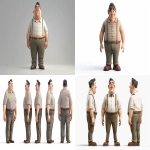

](https://images.ai-img.art/thumbnails/150/1871c145bfe0276c6e1bacf6ec0da6d2dae71370bf71674589af29a201acdd5f.webp)


![**ultra detailed 8k cinematic black and white beauty portrait of a young woman from chest up, vertical frame, face, hands and hair filling the composition, smooth neutral grey studio background with soft dark vignette on the edges, center of the frame is her eye, lips and finger in a "shh" gesture oval symmetrical face with soft but well defined features, ultra smooth flawless skin, no pores, no wrinkles, perfect beauty retouch, straight elegant nose with soft highlight along the bridge and gentle shadow under the tip full sensuous lips with a sharp cupid’s bow, slightly parted, a thin bright glossy highlight strip on the lower lip emphasizing volume, subtle light reflection on the lip gloss one eye visible through a gap between fingers, other eye mostly hidden by the upper hand, long thick eyelashes like fake lashes, small bright catchlight in the pupil, upper eyelid with smoky eye makeup, darker tone along lash line fading smoothly towards the brow, dark thick well shaped eyebrows, gently arched, not overdramatic dark wavy hair, big glossy waves falling down, one clear S-shaped wave on the right side of the frame, soft highlights along the strands to show texture, hair swept away from the cheeks so the face is not covered both hands in thin semi-transparent black gloves up to the forearm, upper hand placed horizontally across the upper face, back of the hand towards camera, fingers slightly spread so that one finger is above the brows and another lower finger creates a narrow gap that reveals the eye, fingertips long and tapered, sharp stiletto-like nails visible under the sheer fabric, subtle darker seams along the fingers and glove edges lower hand bent so that the index finger is vertical and gently touching the center of the lips in a classic "shhh" pose, [...]** - Image #1 <@1264899319799222315>](https://images.ai-img.art/thumbnails/150/ff5a24c7c060f5350508823c406c28c9596aea4e37eefb60abc0f37504a37383.webp)
![**ultra detailed 8k cinematic black and white beauty portrait of a young woman from chest up, vertical frame, face, hands and hair filling the composition, smooth neutral grey studio background with soft dark vignette on the edges, center of the frame is her eye, lips and finger in a "shh" gesture oval symmetrical face with soft but well defined features, ultra smooth flawless skin, no pores, no wrinkles, perfect beauty retouch, straight elegant nose with soft highlight along the bridge and gentle shadow under the tip full sensuous lips with a sharp cupid’s bow, slightly parted, a thin bright glossy highlight strip on the lower lip emphasizing volume, subtle light reflection on the lip gloss one eye visible through a gap between fingers, other eye mostly hidden by the upper hand, long thick eyelashes like fake lashes, small bright catchlight in the pupil, upper eyelid with smoky eye makeup, darker tone along lash line fading smoothly towards the brow, dark thick well shaped eyebrows, gently arched, not overdramatic dark wavy hair, big glossy waves falling down, one clear S-shaped wave on the right side of the frame, soft highlights along the strands to show texture, hair swept away from the cheeks so the face is not covered both hands in thin semi-transparent black gloves up to the forearm, upper hand placed horizontally across the upper face, back of the hand towards camera, fingers slightly spread so that one finger is above the brows and another lower finger creates a narrow gap that reveals the eye, fingertips long and tapered, sharp stiletto-like nails visible under the sheer fabric, subtle darker seams along the fingers and glove edges lower hand bent so that the index finger is vertical and gently touching the center of the lips in a classic "shhh" pose, [...]** - Image #2 <@1264899319799222315>](https://images.ai-img.art/thumbnails/150/d87499f6bdc5a4a822aea4674654f70073b052542a1aaa1d08461a13ca2e07f9.webp)

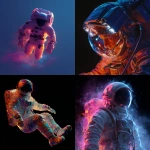

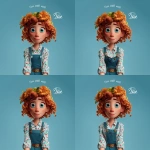

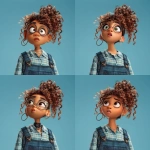
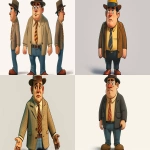
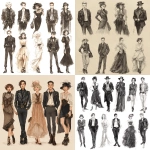



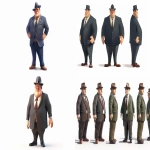
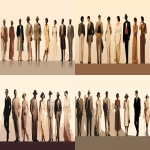
](https://images.ai-img.art/thumbnails/150/d08f607caf4a5c380defef68b778febb8911e8e51e51927b09ed67880bd3084b.webp)
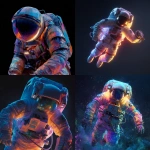


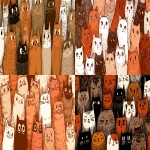


![**ultra detailed 8k cinematic black and white beauty portrait of a young woman from chest up, vertical frame, face, hands and hair filling the composition, smooth neutral grey studio background with soft dark vignette on the edges, center of the frame is her eye, lips and finger in a "shh" gesture oval symmetrical face with soft but well defined features, ultra smooth flawless skin, no pores, no wrinkles, perfect beauty retouch, straight elegant nose with soft highlight along the bridge and gentle shadow under the tip full sensuous lips with a sharp cupid’s bow, slightly parted, a thin bright glossy highlight strip on the lower lip emphasizing volume, subtle light reflection on the lip gloss one eye visible through a gap between fingers, other eye mostly hidden by the upper hand, long thick eyelashes like fake lashes, small bright catchlight in the pupil, upper eyelid with smoky eye makeup, darker tone along lash line fading smoothly towards the brow, dark thick well shaped eyebrows, gently arched, not overdramatic dark wavy hair, big glossy waves falling down, one clear S-shaped wave on the right side of the frame, soft highlights along the strands to show texture, hair swept away from the cheeks so the face is not covered both hands in thin semi-transparent black gloves up to the forearm, upper hand placed horizontally across the upper face, back of the hand towards camera, fingers slightly spread so that one finger is above the brows and another lower finger creates a narrow gap that reveals the eye, fingertips long and tapered, sharp stiletto-like nails visible under the sheer fabric, subtle darker seams along the fingers and glove edges lower hand bent so that the index finger is vertical and gently touching the center of the lips in a classic "shhh" pose, [...]** - Image #4 <@1264899319799222315>](https://images.ai-img.art/thumbnails/150/8507c113aa12343ebd50af4ab9c637a6cf1acf21c55772271eb6a66bb04fa39c.webp)



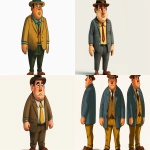


](https://images.ai-img.art/thumbnails/150/7c4350a99935771fe343a7ae65c780cf4cd6b861e69cdc32bd58a3a92fb2476f.webp)

